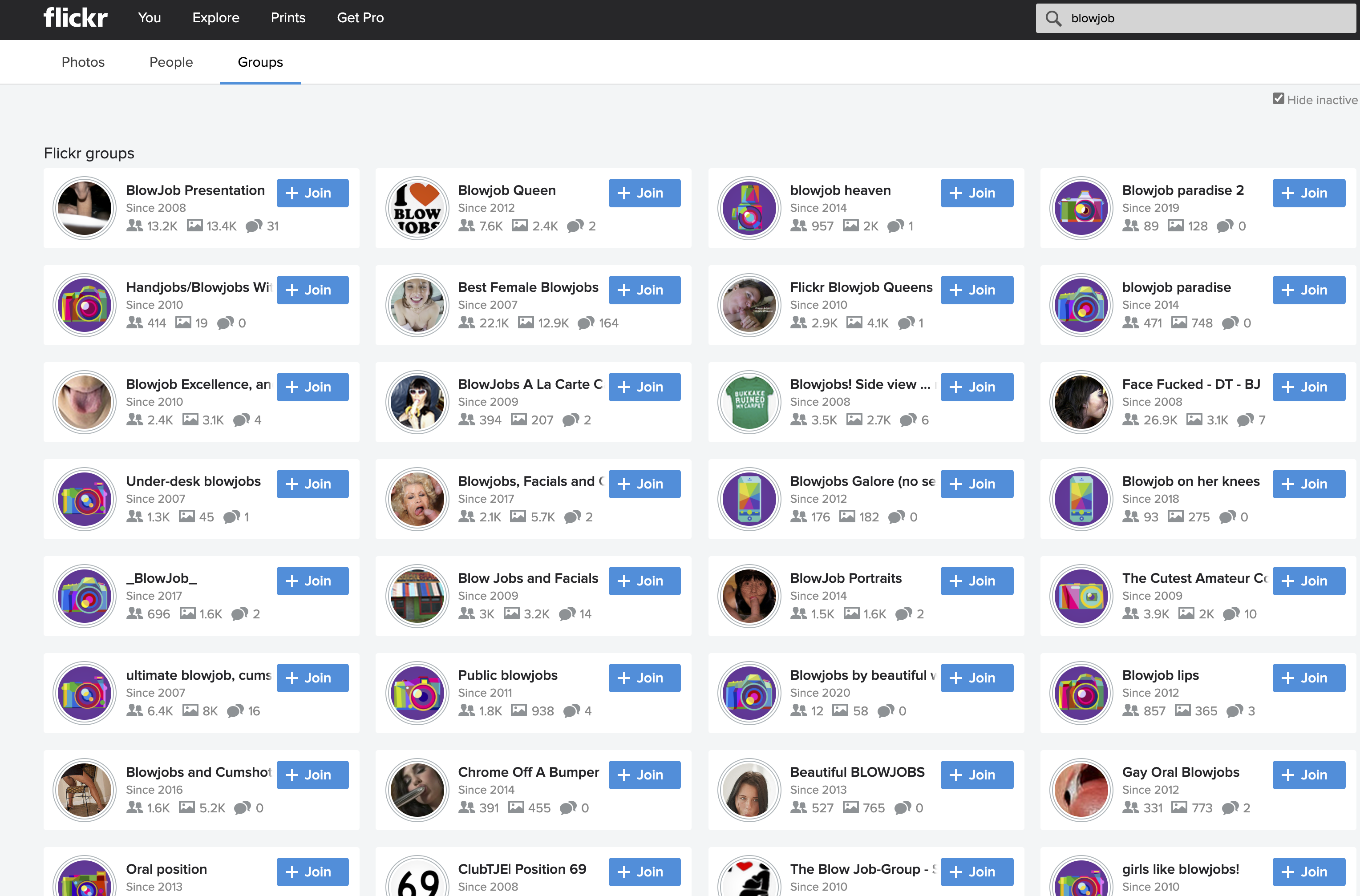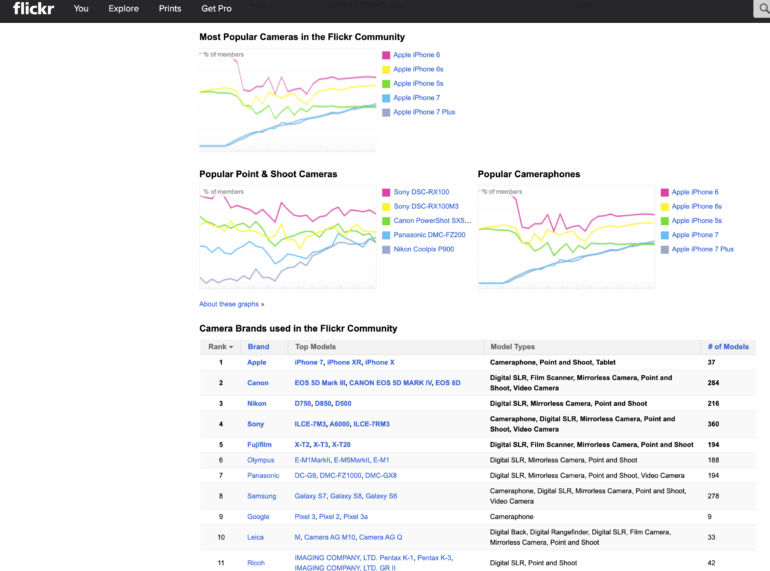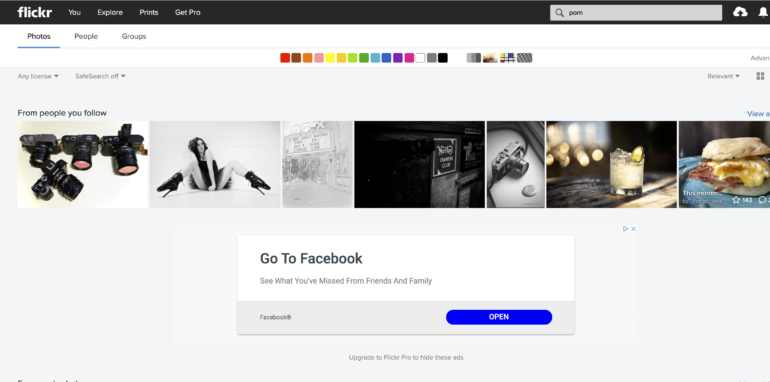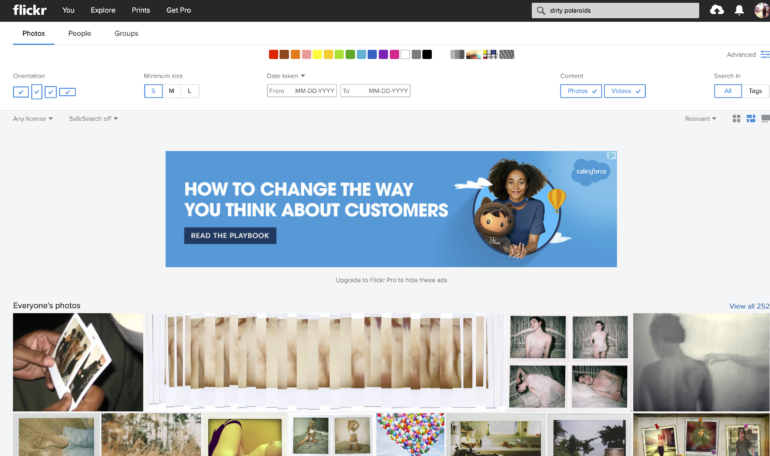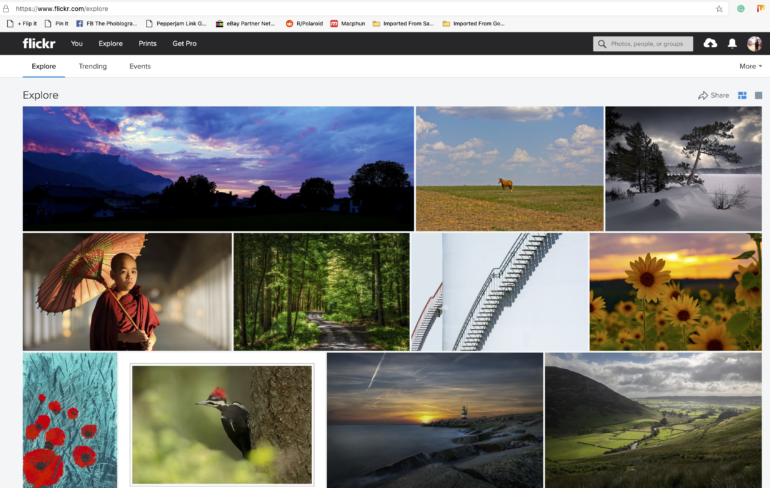Last Updated on 08/30/2020 by Chris Gampat
Tumblr had the hammer brought down on them for NSFW content, but Flickr avoided this somehow.
“Always thought that was more of a 500px thing,” said Phoblographer’s Reviews Editor Paul Ip in our staff Facebook chat. The rest of the staff agreed and never knew about the porn community on Flickr. To Mr. Ip’s point, 500px was always known for its affinity for nudes produced by Russian photographers. Depending on how liberal-minded you are, nudity and pornography aren’t the same things. Most people probably aren’t aware of Flickr’s more wild side. Ask most photographers in your friend circle or network, and you’ll find that most don’t use Flickr anymore. If they do, then they’re probably over the age of 35.
Where Instagram courted the most recent generation of photographers, Flickr captured the hearts of those who remember the early days of broadband. Much has changed on the web since then, but a lot of Flickr has stayed the same. When Marissa Mayer bought Flickr on behalf of Yahoo!, it didn’t seem like she got the help she needed to transform it. The terrible comments Ms. Mayer made about photographers perhaps didn’t make things any better. But Yahoo! also bought Tumblr and tried to clean it up of all NSFW content. Somehow or another, Flickr avoided the same fate. Perhaps the lack of knowledge of these communities within Flickr is one reason for that.
What Photographers Think
We’ve found that most working professional photographers and hobbyists probably don’t use Flickr actively. In its heyday, it was primarily a community for photographers to hang out and talk art/gear/shop in addition to showcasing their photos. After a shoot, it was common to edit, create an album, write a description, and upload the images with specific keywords–the predecessor to hashtags. Then you’d submit and share your photos to various groups. This got your photos more exposure as the main news feed showed activity from your groups, your friends, and the Flickr community at large. There was and still is no algorithm the way that Facebook and Instagram have. With this in mind, most photographers rarely interact with the community anymore, but some are aware of its more carnal side.
“I’ve seen some of the weird porn stuff pop up from time to time, but I’ve never really interacted with it,” says photographer and magazine editor Stan Horaczek. “It’s slightly surprising that Yahoo! didn’t nuke that behavior like it did for Tumblr, but now I guess it’s whatever keeps the users around.” Mr. Horaczek has been a photographer for a very long time, and mostly uses Flickr these days as a backup and storage spot. But he’s also realized its value as a place to find photos from specific lens and camera combinations. For example, if you’re looking for a vintage lens on a Micro Four Thirds camera, Flickr probably has some user that’s uploaded a detailed result. So you can make the decision before you open your wallet.
Stan represents a group of photographers and shooters that have dominated Flickr for years–the passive uploaders. After the iPhone became the most popular camera on Flickr, the platform mostly became a dumping ground. This type of user probably doesn’t go there often, if at all. They use it as an archive–and they range from individuals to companies. These users include NY’s MTA, NASA, and more – lots of folks also use services like Apple’s iCloud, Google Drive, etc.
Some photographers may go to Flickr for inspiration. Take Michael Moeller, for example. His workflow involves using Flickr as a backup for his photos from EyeEm. He isn’t a part of groups, and he doesn’t go, “…hunting for likes.” But he’ll go there for inspiration every now and again.
“…while it’s always been evident that there are loads of great photographers on there, it’s also evident that it’s just a dumping ground for the iPhone. Apple remains at the top of the most used cameras with of course the iPhone 6 taking the lead, but even beating out the Samsung Galaxy lineup are Canon DSLRs.”
Flickr’s Most Popular Dedicated Camera of 2015 is the Canon 5D Mk III
“I am aware of the porn community,” Photographer John Schafer admits. “I became aware from looking at accounts of people who’d (favorited) my photos and realizing they were viewing them in ways I hadn’t intended.” John is indifferent to all this–but he acknowledges that photography purists are probably fuming about Flickr being used for anything else besides being a place to share art.
“Personally, I don’t care. More people means more reach, and I don’t need to be the judge of what’s permitted and what isn’t.”
Mr. Schafer has long used the platform in the way it was intended to be used–as a photo community and marketing tool. There was a time when Mr. Schafer used it to make licensing sales. But according to him, it’s been years since he was able to track sales from his Flickr account. However, he claims to still be a bit active in the groups. “Since I use it for marketing, groups increase exposure, and that’s why I use them,” states John. “There are a few I actually enjoy browsing, too – mostly landscape, travel, and outdoor adventure groups.”
A few others have known too. Like Mr. Moeller, photographer Nathan Blaney has always surfed Flickr for inspiration and used to be a heavy user, but never really added anything to groups. He did, however, have a stint running a group and giving away free PRO accounts. He’s known about these groups for a while too. “OMG, yes,” says Nathan to us in a chat message. “There’s some seriously hardcore stuff on Flickr.” According to Mr. Blaney, all you have to do is check out who is paying attention to your photos. Then you take a look at their favorites and figure it all out. Sometimes, you look at the groups that pictures are in, and you can discover so much.
“I’m surprised people share this stuff so publicly and I block people all the time who are producing or sharing. I don’t want them interacting with my content, even if it’s my photos of flowers!”
Nathan Blaney
There are, of course, photographers who don’t like the pornographic content on Flickr. Friend of the Phoblographer, Ian Pettigrew, is one of the folks we spoke to who knew about the pornographic side of Flickr. “It was the porn that became the turnoff on Flickr,” Mr. Pettigrew tells us. “I prefer a site that is better curated and moderated. I was trying to keep it classy on some of the Nude pages (when I used to shoot that stuff).” Ian admits to barely using Flickr anymore, but it’s primarily because it affected his business. He’d find lots of companies using his images illegally, and he ended up in 10 different court battles with those companies. Understandably, Ian believes that if you’re a professional photographer trying to keep a good reputation, stay off of Flickr.
“The hard-core porn was the biggest turnoff, especially for a professional photographer keeping your reputation intact. But the last straw was Flickr going to a Pay-only site, and saying they will delete ALL but 1,000 of my images if I don’t pay.”
Ian Pettigrew
Mr. Pettigrew isn’t the only person turned off by the pornographic content on Flickr, though. Long time photography blogger and Youtuber Gordon Laing of Camera Labs was also aware of Flickr’s haughtier side. Mr. Laing’s experience with Flickr is mostly for hosting high-resolution sample photos for his camera reviews. “Yes, I’m aware there’s a bunch of adult content on there, but I don’t view it or contribute to it,” says Gordon. “It doesn’t bother me.” Mr. Laing thinks that a lot of “less graphic creators” are heading to YouTube and Only Fans. Despite all of this, Gordon believes that Flickr still has a lot of potential under Smugmug.
After the Smugmug purchase of Flickr, some photographers returned to the platform with renewed faith. Photographer Geoff Livingston shares with us that this was one of the reasons why he returned after a hiatus. “I have seen one or two guys post just straight up reels of pornography,” says Geoff. Considering this, he still believes that Smugmug is doing an excellent job with the network. “Generally, I simply post my images to be seen by other photographers and to gauge how they perform. Unlike Instagram and other social networks, there is no algorithm managing the stream.” Mr. Livingston sees this as an advantage since it means that everyone can see his work. To Geoff, the algorithms are just awful and harm the art of photography by making visibility conditional on like-based popularity and advertising spends.
“Frankly, Instagram is a public network and not a photography network. Just because a photo doesn’t perform well there doesn’t mean it is a poor photograph. And I have had several instances where a photo underperformed on IG, but crushed it on Flickr. Not everyone on Flickr is a professional, but at least they care enough about their photography to post it on a photo-only network and participate in the stream.”
Geoff is also a pretty active user and engages in various groups. For example, he recently had four of his Black Lives Matter photos featured on Flickr’s Explore. He even takes part in the Flickr Friday challenges. This is how Flickr was initially designed and marketed to serious photographers and those passionate about the art form.
Deep Diving
If one goes to Flickr and types in similar terms that you would into Pornhub, you’ll get results that span all the way back to 2008. We found various groups (NSFW LINKs) dedicated to oral acts and other popular search terms. Folks sharing images around their common hobby is a tale as old as the internet–but it snowballs from there. After typing in your search terms, switch from the groups search setting over to the photos search setting, and then set the license to Commercial Use Allowed. You’ll find tons of images. These images range from CGI, phone photos, photos from dedicated cameras, etc.
This could probably lead to some enormous compound problems. For example, revenge porn has become a growing issue in society. With Flickr being a passive place for photo storage, there are probably thousands of images there that have been uploaded without two ways of consent–and many that the copyright originator probably never thought about. If a couple ever parted for one reason or another, not only are the images on one of their phones but also in the theoretical cloud. Worse yet–those images could legally be used for commercial reasons. Flickr, and therefore SmugMug, could potentially set itself up for a significant lawsuit if this were the case. What’s more, SmugMug and Flickr found a way to also advertise to people using Google Ads. Using Google Ads on NSFW results is usually a violation of their terms, and SmugMug says that you can remove the ads by upgrading to Flickr Pro.
It’s even still active today. Take Flickr Group SEX! SEX! SEX! SEX! SEX! for example. Users share their locations with one another even into today. Another group, Best Female Blowjobs, has a thread started in 2012 that’s still active even today. We reached out to a few people who are engaged in these groups but didn’t receive many responses but user labiatastr3 was willing to talk to us. According to her, she’s been using Flickr for a while because it’s a free platform to share stuff like this–and the interactions have been very positive. “Most everybody likes seeing naked women and sex pictures,” she states. “It’s a turn-on knowing guys (and girls) are appreciating our photos, making nasty comments, and pleasuring themselves. It gives normal people the ability to be porn stars.” She continued to say that some pictures have been viewed almost 400,000 times! Despite all this though, she’s very discreet and she’s never needed to pay for Flickr’s Pro services.
The flipside of the coin, though, is that besides the pornographic content on Flickr, there are also artistic nudes. Dirty Polaroids, for example, have long been considered creative works and have even been hung in galleries. Books have been written in their celebration. Friend of the Phoblographer Lester Cannon also still uploads intimate portraits there. Tumblr faced this same issue and ended up getting rid of all content that it thought was even vaguely NSFW. This made them more valuable because it also turned them into a more legitimate social media platform, at least according to what you might see comparatively. Issues like this are abundant, even on Facebook, on Instagram, and more.
The Cult of Flickr and Escaping Tumblr’s Fate
Nothing gold can stay. Flickr isn’t the golden place it was years ago. With fewer users, no one really paid them much attention. Indeed, the Phoblographer has been one of the only publications to report on significant happenings from Flickr. And because of a smaller user base, Flickr probably avoided the NSFW purge Tumblr received. Yahoo! purchased both Tumblr and Flickr–but decided to ban all NSFW content from Tumblr. This move made it more attractive for the eventual sale to WordPress. And though Tumblr still seems like a fantastic place for photography and photographers, the community has arguably changed a whole lot. While Tumblr had the spotlight on its gutting process, Flickr remained unnoticed until Smugmug purchased it. Lots of changes that count have been brought to Flickr since then, but the community is still far from it was a decade ago.
Despite Flickr’s decline, it’s still used by some serious photographers. Trey Ratcliff, who grew to fame because of Flickr, still uploads images. Other big names include Thomas Hawk and Rinzi Ruiz–who all use the platform the way it was intended to be used. Other photographers like Lindsay Adler hopped off years ago. But, of course, you don’t have to be famous or an influencer to use Flickr. Lots of Flickr Groups still have vibrant life about them. One of the most controversial is the Hardcore Street Photography group. This Flickr group houses members that include some of the most well-known street photographers today.
A recent happening has proven evident that Flickr is also an excellent place for companies to interact with a specific market segment. Most marketers with a budget these days go to Facebook and Instagram to try to target photographers. But Fujifilm recently found excellent success on Flickr with a contest they held. Every participant was limited to a single photo, and the company got nearly 8,000 submissions. If you consider the entries of most photography contests these days, you’ll realize that that’s a very satisfactory number considering that it’s a highly targeted group. The cult that still lives on and actively engages with Flickr makes a whole lot of sense from a marketing perspective if you’re a prominent camera manufacturer. But at the same time, Smugmug still has a lot of work to do with Flickr–and we wonder if it’s possibly too late.


